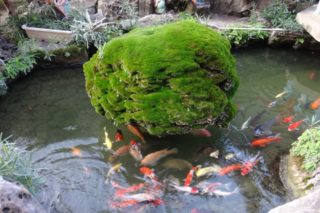
Choosing the best plants for your outdoor koi pond is a process of finding plants that your koi won’t eat or uproot, and plants that won’t become invasive if they get out of your pond and into your local ecosystem. You also have to find plants that will keep coming back year after year, so you’re not stuck spending money on replacement plants every spring.
These reviews bring together the top plant picks for koi ponds. We’ve scoured the internet to find the best plants to meet all of your needs, including enriching the environment for your koi and enhancing your pond.
We’ve also rated the plants for their risk of becoming invasive. This will vary depending on the area you live in, but some plants are able to become invasive just about anywhere, while others are limited to specific environments.

A Quick Look at Our Favorites for 2024
| Rating | Image | Product | Details | |
|---|---|---|---|---|
| Best Overall | 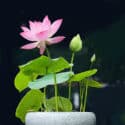 | Water Lotus | Check Price | |
| Best Value | 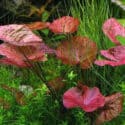 | Tiger Lotus | Check Price | |
| Premium Choice |  | Water Lily | Check Price | |
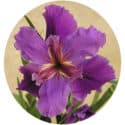 | Louisiana Iris | Check Price | ||
 | Elodea | Check Price |
The 10 Best Plants for Koi Ponds
1. Water Lotus – Best Overall
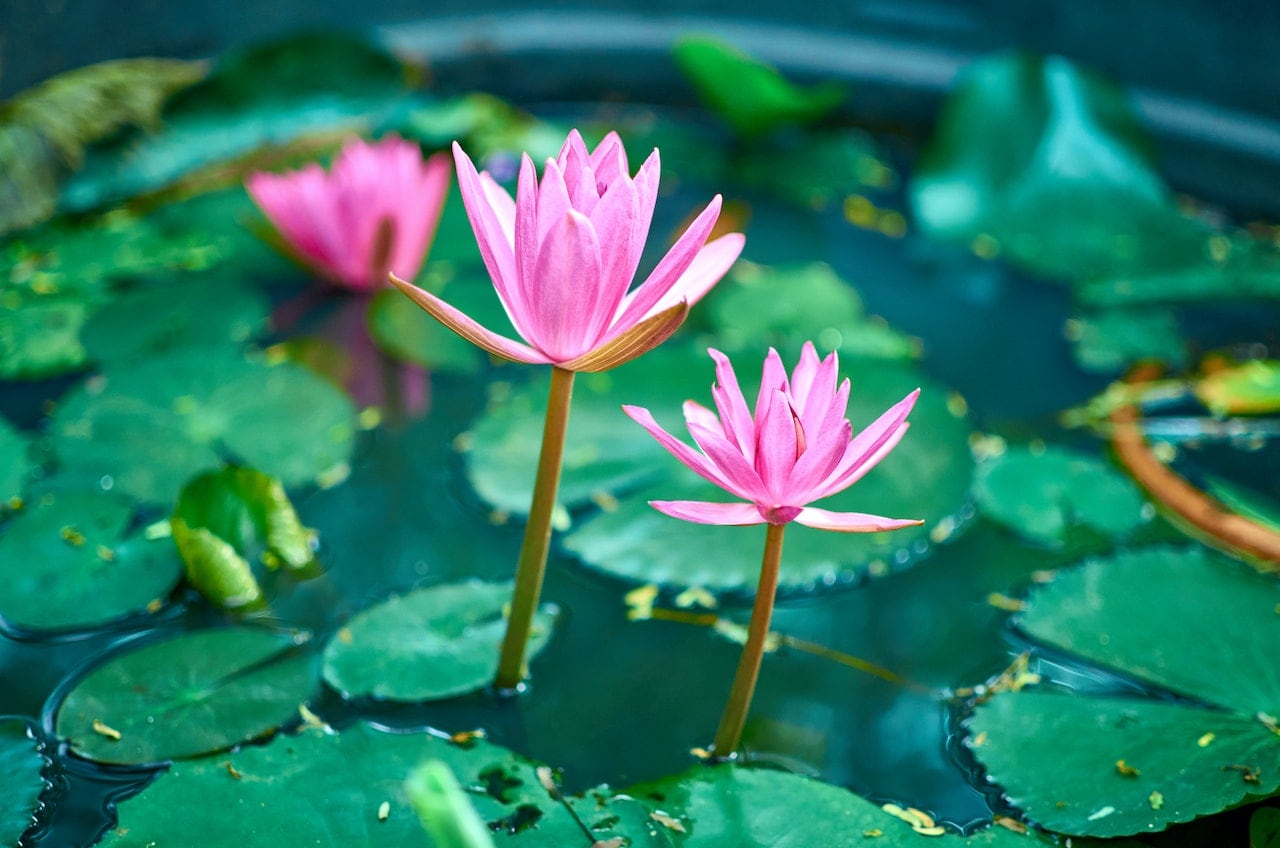
| Growth rate | Moderate to fast |
| Max height | 3–5 feet |
| Risk of becoming invasive | 3/5 |
| Water temperature | 75–87°F |
The best overall plant for your koi pond is the Water Lotus. This beautiful plant is often confused with the Water Lily but lacks the slit in the leaves present in Water Lily leaves. The large, round leaves are great for providing shade to koi and supporting populations of small insects and crustaceans that are eaten by the koi.
These plants grow quickly and produce beautiful blooms. Depending on the variety, they can be planted as shallow as 2 inches and as deep as 18 inches or more. They are easily propagated and reproduce without assistance very well.
There is an American Water Lotus that is characterized by yellow blooms. Blooms of other colors belong to imported Water Lotus varieties. All imported Water Lotuses have the potential to become invasive, especially in areas that are warm year-round. American Water Lotuses are invasive in some parts of the country as well.
If allowed to grow freely, these plants will take over the surface of the pond and are known to support mosquito reproduction. Be aware that these plants don’t always bloom in the first year.
- Provide lots of shade
- Support insect and crustacean populations
- Grow quickly
- Produce colorful, large blooms
- Can be planted at varying depths
- Easily propagated
- Invasive
- Can take over the surface of the pond
- Support mosquito larvae
- Doesn’t always bloom during the first year
2. Tiger Lotus – Best Value
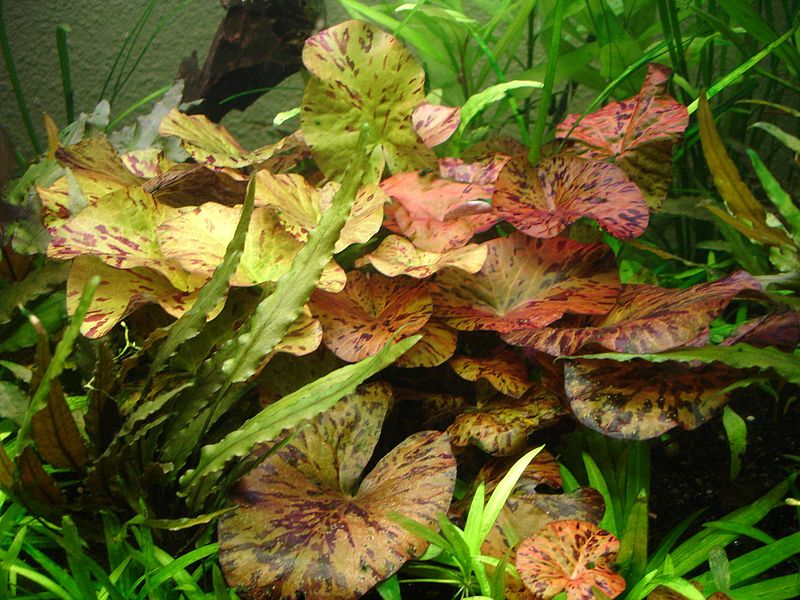
| Growth rate | Moderate to fast |
| Max height | 2+ feet |
| Risk of becoming invasive | 2/5 |
| Water temperature | 71–86°F |
The best plant for koi ponds for the money is the Tiger Lotus, which produces gorgeous red leaves with distinct tiger-like striping. Although they share the “Lotus” name with the Water Lotus, these plants are not related and are actually in the same family as Water Lilies. Tiger Lotus leaves are slightly heart-shaped and typically only reach a few inches in width.
While these plants can flower, they are highly sought after for their colorful foliage. They typically produce leaves that stay below the water’s surface, making the leaves a great place for koi to hang out away from the surface and a great location for koi to lay eggs.
If allowed to escape your pond, these plants can become invasive, especially in warm areas. They are smaller than many other pond plants and since they don’t grow much above the waterline, they may be difficult to see in a pond environment. Although they do produce flowers, it isn’t a routine occurrence.
- Cost effective
- Colorful foliage
- Leaves don’t get too large
- Allow koi shade away from the water’s surface
- Great environment for eggs
- Invasive
- Doesn’t typically grow above the waterline
- Doesn’t routinely produce flowers
3. Water Lily – Premium Choice
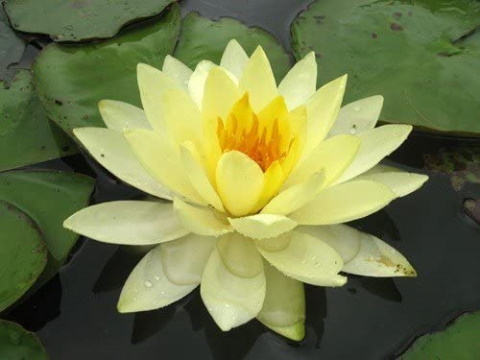
| Growth rate | Fast |
| Max height | 1–4 feet |
| Risk of becoming invasive | 2/5 |
| Water temperature | 70–80°F |
Water Lilies make a good pick for something that falls under a more premium price. These plants typically stay smaller than Water Lotuses and do well in shallow water. Their large leaves, or lily pads, provide excellent shade to koi and support the insect and crustacean populations that koi feed on. They grow well in cooler water than Water Lotuses, making them a good pick for koi ponds in cooler areas.
These plants grow so rapidly that they typically are producing leaves at the water’s surface less than two weeks after sprouting. Water Lilies produce large, distinct flowers that come in a variety of colors, including white, yellow, pink, and purple.
While there are some Water Lilies native to the United States, there are some imported varieties as well. All Water Lilies are considered invasive in areas they don’t naturally occur in, including parts of the US. The large leaves support mosquito larvae growth and may block too much light, stunting the growth of plants lower in the water.
- Do well in shallow water
- Provide lots of shade
- Support insect and crustacean populations
- Grow very quickly
- Produce colorful, large blooms
- Grow well in cooler water than some other plants
- Invasive
- Support mosquito larvae
- May block sunlight to lower plants
- Premium price
4. Louisiana Iris
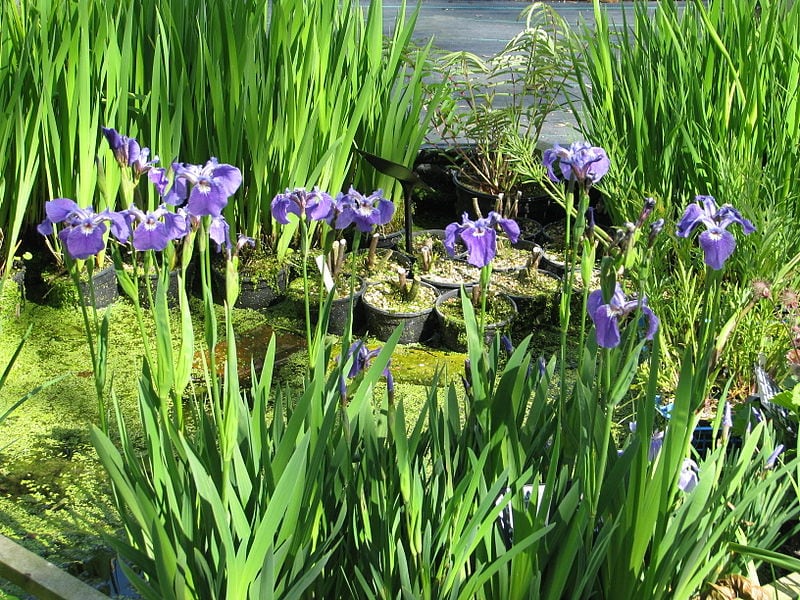
| Growth rate | Slow |
| Max height | 2–3 feet |
| Risk of becoming invasive | 1/5 |
| Water temperature | 65–86°F |
The Louisiana Iris is a group of five types of Irises that are native to Louisiana and other parts of the American Southeast. All five plants in this grouping grow under the same conditions and have similar appearances with long, pointed leaves.
The plants are known for their colorful, large flowers that can reach 4–6 inches in width. They come in multiple colors, including purples, blues, pink, brown, red, and yellow, to name a few. These plants begin growing in the fall, usually around October, and grow slowly until they begin blooming in spring. They grow well in ponds and boggy areas, but they can also thrive on pond edges and in other areas with damp soil.
Unless you ignore your Louisiana Irises for multiple years, they have a low risk of becoming invasive.
The slow growth rate of these plants may be a negative for people who prefer fast payoff after planting. Routine pruning is necessary to keep these plants under control, otherwise, they do run the risk of becoming invasive after a few years of neglect.
To ensure blooming occurs, your Louisiana Irises should receive at least 6 hours of sun daily. They only bloom from March to April, so their short blooming season is a negative for many people.
- Five species to choose from
- Produce colorful, large blooms
- Can grow in ponds or soil
- Low risk of becoming invasive
- Propagate easily
- Require regular pruning to prevent overgrowth
- Need 6+ hours of sun daily to ensure blooming
- Only bloom from March to April
5. Elodea
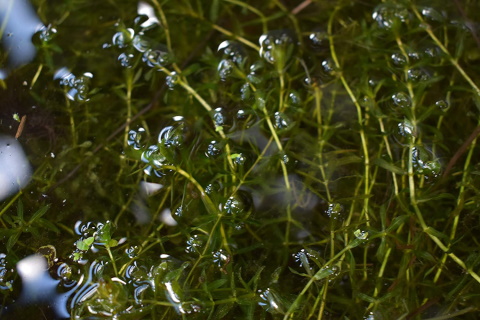
| Growth rate | Fast |
| Max height | 3 feet |
| Risk of becoming invasive | 4/5 |
| Water temperature | 60–75°F |
Elodea, also called Anacharis, is a fast-growing plant that is widely sold as an aquarium plant. It can reach up to 3 feet under most circumstances, although wild Elodea is reported to reach up to 9 feet in height. This is a stem plant that is usually grown in bunches, giving it an appearance reminiscent of seaweed.
While your koi may snack on this plant, it grows rapidly enough that it should replenish itself quickly. It’s hardy and can grow back after being chewed down.
This plant carries a high risk of becoming invasive if allowed to enter natural waterways, so only use this plant in outdoor ponds that have no chance of flooding into local waterways or drainage pipes. In nature, this plant can impede waterways, creating homes for mosquito larvae and reducing necessary waterflow for wildlife.
Check your local laws before adding Elodea to your pond because it is illegal to sell or own in some areas. It doesn’t grow above the waterline and doesn’t flower, so this isn’t a plant you purchase for the aesthetic it creates.
- Grows quickly
- Creates underwater fields of plants for your koi
- Typically grows back before koi can eat all of it
- Hardy
- Good pick for deeper ponds
- High risk of becoming invasive
- Illegal to own in some areas
- Support mosquito larvae
- Doesn’t grow above the waterline
6. Hornwort
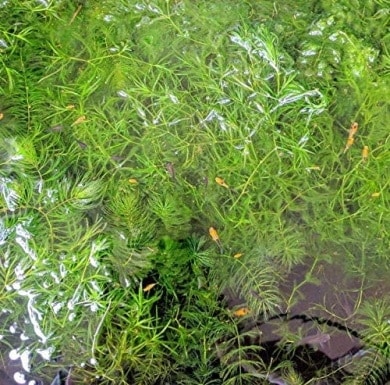
| Growth rate | Fast |
| Max height | 6–10 feet |
| Risk of becoming invasive | 0/5 |
| Water temperature | 50–86°F |
Hornwort is a great plant for koi ponds because it can be floated or planted. This means that if your koi uproot it, it will continue to grow while floating. It can provide underwater plant fields for your koi, as well as creating shade if floating. It has small, prickly leaves that are typically unappetizing to most fish, so it’s unlikely to be eaten by your koi.
Hornwort has practically no risk of becoming invasive because it is native to the entire US and parts of Canada. It’s hardy and easy to grow, making it a great plant to plant and forget.
Although Hornwort can reach 10 feet in height, it does not grow above the waterline. While it does flower, the flowers are insignificant and unattractive. It grows best in medium to high lighting, so if your pond is located in a shady area, this plant is likely to begin shedding its spine-like leaves, which can be messy and clog up filtration systems.
- Can be floated or planted
- Can create underwater fields or shade
- Unlikely to be eaten
- Native to the US
- Hardy and easy to grow
- Doesn’t grow above the waterline
- Flowers are insignificant
- Will shed its leaves in low lighting
- Can be messy and clog filters and other equipment
7. Dwarf Egyptian Papyrus
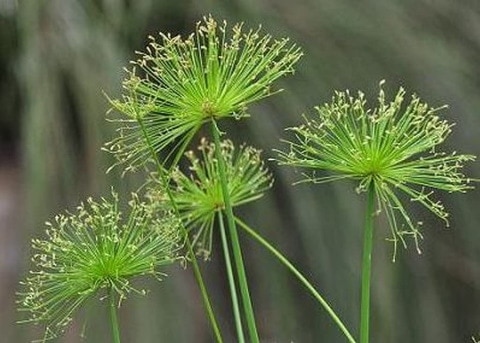
| Growth rate | Fast |
| Max height | 2–3 feet |
| Risk of becoming invasive | 1/5 |
| Water temperature | 60–75°F |
If you’re interested in an unusual plant for your koi pond, then Dwarf Egyptian Papyrus may be just what you’re looking for. This plant prefers to be grown in shallow water that is only a few inches deep, but it can also be grown as a terrestrial plant in areas where the ground stays wet all the time, like on the edge of a pond.
The Dwarf Egyptian only gets to be 3 feet tall but spreads outward, putting out plantlets throughout the growing season. It doesn’t produce typical flowers, but it does create flowering offshoots that resemble exploding firecrackers with tiny flowers on the ends. Dwarf Egyptian Papyrus is at a low risk of becoming invasive unless it is neglected for multiple years.
Since this plant creates unusual flowering stalks, it may not be a good fit for someone looking for a plant with brightly colored flowers. It is not cold hardy, often needing to be taken indoors or into a greenhouse over the winter. It requires routine division of offshoots at least annually to keep growth healthy and in check.
If you neglect this plant for multiple years, it has the potential to become invasive.
- Unusual appearance with unique flowers
- Can be grown in water or soil
- Reproduces readily
- Low risk of becoming invasive
- Doesn’t produce brightly colored flowers
- Not cold hardy
- Requires routine rhizome division
- Has the potential to become invasive after many years
8. Horsetail Reed

| Growth rate | Fast |
| Max height | 20–36 inches |
| Risk of becoming invasive | 0/5 |
| Water temperature | 60–85°F |
The Horsetail Reed, also sometimes called the Scouring Rush, is a bamboo-like plant that grows exceptionally quickly on the edges of ponds in damp soil. It grows up to 3 feet tall but stays narrow, making its distribution easy to control.
This plant does not carry a risk of becoming invasive because it is native to almost all of the Northern Hemisphere, including all of the United States. It is cold hardy down to 5°F but won’t begin growing for the season until the ground begins to warm up, usually around 60°F.
This plant does not produce leaves and produces flowers that look like a combination of a cattail and a pinecone, so it does not produce colorful or large blooms. Once you have this plant, it is exceptionally difficult to get rid of, so only plant this if you intend to keep it.
A single plant can live for up to 10 years. Be cautious where you plant Horsetail Reeds because they are toxic to livestock, namely cows and sheep, and may have toxic properties for domestic pets as well.
- Easy to control
- Reaches full height in a couple of weeks
- Native to the US
- Cold hardy
- Doesn’t produce brightly colored flowers
- Difficult to get rid of
- One plant can live up to 10 years
- Toxic to many animals
9. Water Lettuce
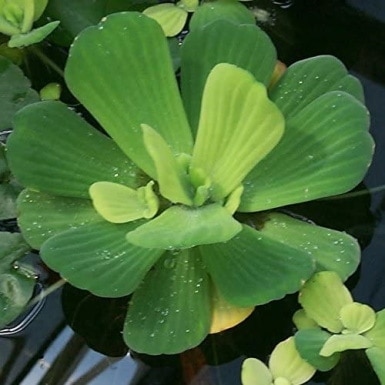
| Growth rate | Fast |
| Max height | 4 inches |
| Risk of becoming invasive | 4/5 |
| Water temperature | 60°F+ |
Water Lettuce is a beautiful floating plant that resembles a head of lettuce with trailing roots. It does produce small, fragrant, white flowers and can reproduce sexually or via runners. It is an attractive plant when floating in koi ponds and the long roots make a great home for small crustaceans. Koi may eat these roots, but they will regrow quickly.
Water Lettuce reproduces and grows quickly and while it only grows to about 4 inches tall, it can grow to around 10 inches wide. Once water temperatures reach 60°F, it will typically begin growing and reproducing.
This plant carries a high risk of becoming invasive not just because of its hardy nature, but because it can easily be carried to other bodies of water by flooding. Ensure you only place this plant in a pond that has no chance of flooding into native waterways or drainage pipes. If allowed to cover most of the surface of your pond, it will begin decreasing the oxygen content in the water, leading to fish death.
These plants may be eaten by koi, which will take quite a while to grow back from. Sometimes, these plants can support mosquito larvae growth. It is not cold hardy and will typically die off during periods of frost.
- Produces small, fragrant flowers
- Reproduces readily
- Support crustacean populations
- Begins growing once water temperatures reach 60°
- High risk of becoming invasive
- If allowed to overgrow, it can lead to fish death
- Whole plants may be eaten by koi
- Support mosquito larvae
- Not cold hardy
10. Water Hyacinth

| Growth rate | Fast |
| Max height | 3 feet |
| Risk of becoming invasive | 4/5 |
| Water temperature | 54–95°F |
If your pond is fully enclosed and has no chance of flooding into native waterways, then you will love Water Hyacinth, which produces showy, purplish blooms. These floating plants are eye catching, making them a favorite for ponds and water gardens.
They reproduce quickly, sometimes doubling in number in two weeks. Their rapid growth and reproduction rate mean that your koi are unlikely to eat this plant fully out of your pond. This plant can help support populations of insects and small crustaceans for your koi to eat.
Water Hyacinth carries a high risk of becoming invasive if allowed to enter native waterways. It can block out sunlight to plants below and clog waterways, allowing for mosquito larvae growth and reduced waterflow to wildlife.
The rapid reproduction rate and general hardiness of this plant also adds to the risk of it becoming invasive. A single plant can produce thousands of seeds, which are viable for 30 years or more.
- Produce colorful, large blooms
- Difficult for koi to eliminate
- Support insect and crustacean populations
- High risk of becoming invasive
- Supports mosquito larvae
- Can reduce waterflow
- Extremely fast reproduction
- Plant and seeds are exceptionally hardy
Buyer’s Guide: Choosing the Best Plants for Your Koi Pond
What Benefits Do Plants Have in Ponds?
Adding plants to your koi pond is a fantastic way to improve the overall water quality in your pond. Plants are a good source of oxygen in the water and will help remove CO2 from the water as well. They also pull waste products from the water, specifically, nitrate.
By removing nitrate from the water, plants help keep your koi safe and reduce the available nutrients for algae to consume.
Plants can also add a natural aesthetic to your pond, helping your pond stand out through color and texture and not through an unnatural appearance. They can serve as a breeding ground for fish, insects, and crustaceans, creating an entire ecosystem within an enclosed pond. They also enrich the environment for your koi, making for a healthier and more interesting home.

Choosing the Best Plants for Your Koi Pond
Are They Safe for the Environment?
Your top priority when choosing plants should be to consider the safety for the natural environment. While keeping your koi safe and healthy is important, a negative impact on the native ecosystem has more negative and far-reaching effects than just your koi pond.
Choose plants that are native to the area or that are at no risk of being flooded out into waterways during heavy rain or other environmental events.
Are They Safe for Your Koi?
While many aquatic plants are fish safe, there are some that are not. Ensure any plants you place in your pond are safe for your koi to eat. Koi are likely to attempt to eat or uproot new plants, even if it’s just once, so ensuring any plants you add don’t carry the risk of poisoning your fish will help keep them safe while they explore.
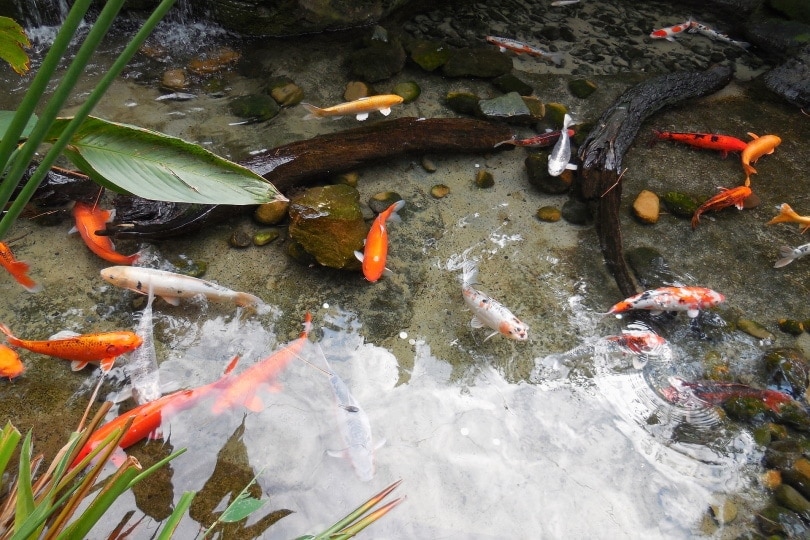
Do They Create the Appearance You want?
What’s the appearance you’re looking for in your pond? Are you interested in flowering plants or plants that stay below the surface? Do you like floating plants? You can choose from tons of types of plants with different appearances, all with their own pros and cons, to help create the pond of your dreams.

Conclusion
The best overall plant for koi ponds is the Water Lotus, which is a gorgeous, hardy plant that carries a moderate risk of becoming invasive. The best value option is the Tiger Lotus, which has attractive foliage. If you’re interested in spending more on pond plants, then the Water Lily may be your favorite option.
Regardless of which plants you choose for your koi pond, you’ll be able to find something to suit your preferences. As these reviews show, choosing plants does take some amount of research and forethought, but adding plants to your pond can create a really stunning visual effect.
Related reads:
Featured Image Credit: Piqsels
